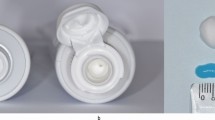Abstract
Introduction Consumer oral hygiene products play a key role in improving and maintaining population oral health. The oral personal care market is rapidly diversifying; a growing number of dentifrices marketed a 'natural' and fluoride-free are entering mainstream retailers, which may have implications for the oral health of the population 'with regards to caries risk.
Aims To investigate the range of fluoride concentrations, flavour formulations and delivery mechanisms of dentifrices available on the UK market.
Methods A cross-sectional survey was used to catalogue dentifrices sold in a range of supermarkets, high-street pharmacy and health chains, and specialist online retailers. In addition, a standard search engine was used to examine dentifrice brands being sold in the UK. The fluoride content was recorded as parts per million (ppm) and the product name data were analysed for key terms using Microsoft Excel. Excluded from the survey were mouthwashes, rinses and non-dentifrice whitening products.
Results Five hundred different toothpaste, tooth powder and tablet products from 95 different brands were recorded. Sixty percent of these contained a fluoride concentration of 1,000 ppm or above. Forty-five percent of all products had the recommended adult concentration of at least 1,350 ppm. Almost one-third (31%) contained no fluoride and 4% of products did not specify the absence, presence or concentration of fluoride.
Conclusions This study has quantified and confirmed the increasingly diverse range of dentifrices for sale in the UK. A large number of fluoride-free products exist within a growing 'natural' and 'organic market'. The study also gives oral health professionals an insight into the diverse types of products available to consumers in order to appropriately advise patients on caries prevention.
Key points
-
Increases awareness of the oral hygiene market.
-
Increases understanding of diversity of dentifrice products available to patients and consumers.
-
Increases understanding of trends in product formulation and of factors affecting patient choices.
This is a preview of subscription content, access via your institution
Access options
Subscribe to this journal
Receive 24 print issues and online access
$259.00 per year
only $10.79 per issue
Buy this article
- Purchase on Springer Link
- Instant access to full article PDF
Prices may be subject to local taxes which are calculated during checkout



Similar content being viewed by others
References
Muhler J C. Joseph Charles Muhler papers, Collection C356. Bloomington: Indiana University Archives, 2009.
Dynata. Simplyhealth Consumer Oral Health Survey. London: Denplan Simplyhealth, 2009.
Chadwick B L, White D, Lader D, Pitts N. Preventive behaviour and risks to oral health - a report from the Adult Dental Health Survey 2009. London: NHS Information Centre for Health and Social Care, 2011.
Schenkel A B. How do different high- and low-concentration fluoride toothpastes compare for preventing dental caries in young children? 2019. Available online at https://www.cochranelibrary.com/cca/doi/10.1002/cca.2549/full (accessed June 2020).
Schenkel A B. How does fluoride toothpaste compare with non-fluoride toothpaste for preventing dental caries in adults? 2019. Available online at https://www.cochranelibrary.com/cca/doi/10.1002/cca.2547/full (accessed June 2020).
Griffin S O, Regnier E, Griffin P M, Huntley V. Effectiveness of fluoride in preventing caries in adults. J Dent Res 2007; 86: 410-415.
Marinho V C C, Higgins J P T, Sheiham A, Logan S. Fluoride toothpastes for preventing dental caries in children and adolescents. Cochrane Database Syst Rev 2003; DOI: 10.1002/14651858.CD002278.
Public Health England. Delivering Better Oral Health: An Evidence-Based Toolkit for Prevention - Third Edition. 2017. Available at https://assets.publishing.service.gov.uk/government/uploads/system/uploads/attachment_data/file/605266/Delivering_better_oral_health.pdf (accessed June 2020).
Levine R, Stillman-Lowe C. Scientific Basis of Oral Health. 6th ed. London: BDJ Books, 2009.
Du L. Key features to stand out in China's changing toothpaste market. 2019. Available at https://www.mintel.com/blog/personal-care-market-news/key-features-to-stand-out-in-chinas-changing-toothpaste-market (accessed June 2020).
Grandview Research. Herbal Toothpaste Market Size, Share & Trends Analysis Report by Distribution Channel (General Store, Hypermarket & Supermarket, Pharmacy Store, Online Retail), By Region, And Segment Forecasts, 2019-2025. 2019. Available online at https://www.grandviewresearch.com/industry-analysis/herbal-toothpaste-market (accessed June 2020).
Lippert F. An Introduction to Toothpaste - Its Purpose, History and Ingredients. Monogr Oral Sci 2013; 23: 1-14.
Rethman M P, Beltrán-Aguilar E D, Billings R J et al. Nonfluoride caries-preventive agents: executive summary of evidence-based clinical recommendations. J Am Dent Assoc 2011; 142: 1065-1071.
Dorri M. Do xylitol-containing products help prevent dental caries in children? 2016. Available online at https://www.cochranelibrary.com/cca/doi/10.1002/cca.1199/full (accessed June 2020).
Riley P, Moore D, Ahmed F, Sharif M O, Worthington H V. Xylitol-containing products for preventing dental caries in children and adults. Cochrane Database Syst Rev 2015; DOI: 10.1002/14651858.CD010743.pub2.
Maden E A, Altun C, Ozmen B, Basak F. Antimicrobial Effect of Toothpastes Containing Fluoride, Xyltiol, or Xylitol-Probiotic on Salivary Streptococcus mutans and Lactobacillus in Children. Niger J Clin Pract 2018; 21: 134-138.
Rölla G, Ögaard B, de Almeida Cruz R. Clinical effect and mechanism of cariostatic action of fluoride-containing toothpastes: A review. Int Dent J 1991; 41: 171-174.
Cosmetics Toiletries and Perfumery Association. CTPA Guide on Classification of Toothpaste Claims: Borderline issues between Cosmetics and Medicinal Products or medical devices Common Understanding. London: CTPA & MHRA, 2018.
Sandier M. The Regulation of Toothpaste (1997 Third Year Paper). 1997. Available online at http://nrs.harvard.edu/urn-3:HUL.InstRepos:8846762 (accessed June 2020).
Medicines & Healthcare products Regulatory Agency. A guide to what is a medicinal product. London: MHRA, 2020.
General Dental Council. Pendlebury Lecture. London: GDC, 2014.
Brown R. Consumers Are Demanding Greater Transparency From Beauty Brands. What does that really mean? 2019. Available at https://www.beautyindependent.com/consumers-are-demanding-greater-transparency-from-beauty-brands-what-does-that-really-mean/ (accessed June 2020).
Gallagher P. Choosing the Best Toothpaste. 2015. Available online at https://www.which.co.uk/reviews/electric-toothbrushes/article/choosing-the-best-toothpaste (accessed June 2020).
Public Health England. Delivering Better Oral Health: An Evidence-Based Toolkit for Prevention - 1st ed. 2007. Available at https://dentallawandethics.co.uk/wp-content/uploads/2016/03/DH-delivering-better-oral-health.pdf (accessed June 2020).
Colgate. Colgate Launches Smile for Good Toothpaste with a New Level of Ingredient Transparency and a First-of-its-kind Recyclable Tube. 2020. Available at https://www.prnewswire.co.uk/news-releases/colgate-r-launches-smile-for-good-toothpaste-with-a-new-level-of-ingredient-transparency-and-a-first-of-its-kind-recyclable-tube-827523949.html (accessed June 2020).
Chard S. Pärla toothpaste tablets - what are they and how are they helping the planet? 2020. Available at https://www.dentistry.co.uk/2020/06/29/parla-toothpaste-tablets-how-helping-planet/ (accessed June 2020).
Grandview Research. Organic Personal Care Market Size, Share & Trends Analysis Report By Application (Cosmetics, Skin, Oral, Hair Care), By Region, And Segment Forecasts, 2019-2025. 2019. Available online at https://www.grandviewresearch.com/industry-analysis/organic-personal-care-market (accessed June 2020).
Davies R M, Ellwood R P, Davies G M. The rational use of fluoride toothpaste. Int J Dent Hyg 2003; 1: 3-8.
Reekie D. Fear of fluoride. Br Dent J 2017; 222: 16-18.
Levine R S. Fluoride in toothpaste - is the expressed total fluoride content meaningful for caries prevention? Br Dent J 2020; 228: 795-799.
Levy S M, McGrady J A, Bhuridej P et al. Factors affecting dentifrice use and ingestion among a sample of U.S. preschoolers. Pediatr Dent 2000 22: 389-394.
Levy S M, Maurice T J, Jakobsen J R. Pilot study of pre-schoolers' use of regular flavored dentifrices and those flavored for children. Pediatric Dent 1992 14: 388-391.
Morosini D. 2016 Is The Year Of Luxury Dental Care - But Is It Worth It? 2016. Available at https://graziadaily.co.uk/life/health-fitness/2016-year-luxury-dental-care-worth/ (accessed June 2020).
Mull A. Who Would Spend $17 on Toothpaste? 2018. Available at https://www.theatlantic.com/health/archive/2018/11/luxury-toothpaste-instagrams-latest-trend/576343/ (accessed June 2020).
Lambert M J, Vanobbergen J S N, Martens L C et al. Socioeconomic inequalities in caries experience, care level and dental attendance in primary school children in Belgium: a cross-sectional survey. BMJ Open 2017; DOI: 10.1136/bmjopen-2016-015042.
Public Health England. Fiscal and pricing policies to improve public health: a review of the evidence. 2018. Available at https://assets.publishing.service.gov.uk/government/uploads/system/uploads/attachment_data/file/743118/Fiscal_and_Pricing_Policies_report_FINAL.pdf (accessed June 2020).
Seeley A. Briefing Paper: VAT on Sanitary Protection. 2020. Available online at https://commonslibrary.parliament.uk/research-briefings/sn01128/ (accessed October 2020).
Goldman A S, Yee R, Holmgren C J, Benzian H. Global Affordability of Fluoride Toothpaste. Global Health 2008; 4: 7.
Sevastian S T, Siddanna S. Total and Free Fluoride Concentration in Various Brands of Toothpaste Marketed in India. J Clin Diagn Res 2015; DOI: 10.7860/JCDR/2015/13382.6578.
Benzian H, Holmgren C, Buijs M, van Loveren C, van der Weijden F, van Palestein Helderman W. Total and free available fluoride in toothpastes in Brunei, Cambodia, Laos, the Netherlands and Suriname. Int Dent J 2012; 62: 213-221.
Public Health England. National Dental Epidemiology Programme for England: oral health survey of 5-year-olds 2019 - A report on the variations in prevalence and severity of dental decay. 2020. Available at https://assets.publishing.service.gov.uk/government/uploads/system/uploads/attachment_data/file/873492/NDEP_for_England_OH_Survey_5yr_2019_v1.0.pdf (accessed June 2020).
Mathaler T M. Changes in Dental Caries 1953-2003. Caries Res 2004; 38: 173-181.
Author information
Authors and Affiliations
Corresponding author
Ethics declarations
The authors declare no conflicts of interest.
Rights and permissions
About this article
Cite this article
Gupta, A., Gallagher, J., Chestnutt, I. et al. Formulation and fluoride content of dentifrices: a review of current patterns. Br Dent J (2021). https://doi.org/10.1038/s41415-021-3424-y
Received:
Accepted:
Published:
DOI: https://doi.org/10.1038/s41415-021-3424-y
This article is cited by
-
In vitro study on the preventive effect of children’s toothpastes on erosive tooth wear of primary bovine enamel and dentin
Scientific Reports (2023)
-
Fluoride distribution, contamination, toxicological effects and remedial measures: a review
Sustainable Water Resources Management (2023)
-
Dental public health breakthrough
British Dental Journal (2022)



